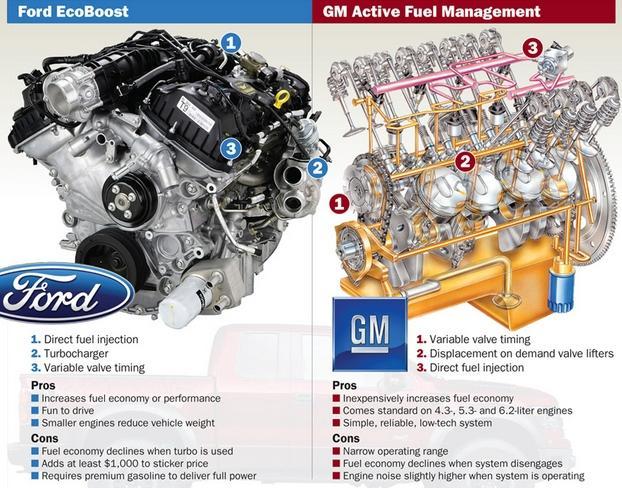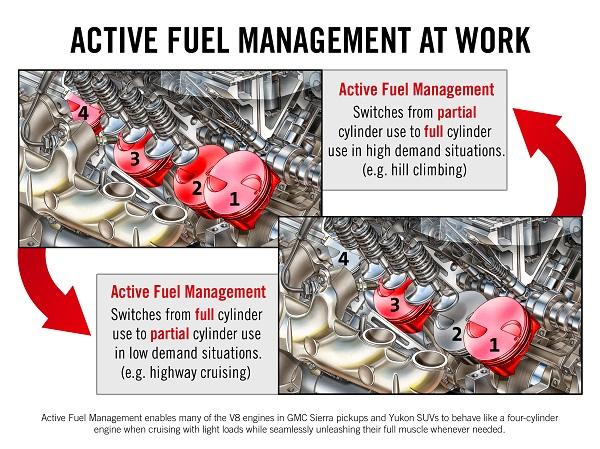Introduction
Engine manufacturers around the world have been struggling to come up with new technologies that are more efficient in terms of fuel consumption, and less expensive in terms of construction. In the field of motor vehicles, the competition has been very stiff. The American car manufacturers have been facing stiff competition from Japan and Germany. These companies have been in constant competition to ensure that they develop engines that meet the needs of their customers at a lower cost.
Holden Motors Company has come up with a new technology that makes big engines act small in an effort to save fuel among the users of the high-performance cars. This technology, popularly known as Active Fuel Management, came at a time when the world is demanding efficient engines that consume less fuel despite their power. According to Werner (2008), this technology reduces the percentage consumption of fuel to about 7.5%. In this report, the researchers will conduct extensive research into this technology as used by Holden Motors Company in order to determine its social, economic, environmental, and ethical impacts on our society.
Sustainability Issues being Addressed
According to Edmonston (2011), the need to achieve sustainability in all sectors of the economy has become increasingly relevant in the modern world. As we exploit natural resources, there is a need to ensure that the future generation is not affected. As Pradeep (2013) puts it, we must find ways of meeting our current economic needs without jeopardizing the ability of the future generation to meet their own needs. A company cannot achieve success if its operations are not sustainable. Many firms have been emphasizing one aspect of sustainability, which is the need to get profits. However, it goes beyond this. Sustainability has three main pillars, as shown in the figure below.

As shown above, sustainability is supported by three pillars that must work as a unit. These pillars are what defined the AFM technology, as discussed below.
Environmental
The need to protect the environment is one of the primary pillars that any business entity should never ignore. The environment supports all other pillars and activities of human beings. When it becomes unsustainable, then business operations cannot continue. The engineers were concerned about the amount of carbon released by its engines into the environment. The Active Fuel Management technology was an initiative that focused on addressing this problem in all its high-performance engines. The system was designed in a way that two cylinders are shut down when the machine is running under a light load, especially at a steady speed. This ensures that the amount of gases released into the environment is reduced as much as possible. The system is also designed to ensure that there is maximum combustion in the engines. This reduces the emission of dangerous gases into the atmosphere.
Social
The second pillar of sustainability is the need to protect the social interests of the members of our society. In this case, Holden Motors Company realized that it is socially responsible for its customers. The AFM technology was meant to serve the interests of the customers of this firm. When a user of the V-8 engine is enabled to pay the cost of a V-6 engine, then it is the user who benefits. This conscious effort to meet the needs of its customers enabled the firm to develop a base of loyal customers.
Economic
According to Hatch (2012), the third pillar, that many firms consider to be the most important to them, is the need to make profits. Firms can make huge profits in two ways. The first way is to increase the price of their products while maintaining the cost of production constant. This is not possible in an industry that has become very competitive. The second option is to lower the cost of production while maintaining the prices of the products. This is the approach that Holden Motors Company has taken with its AFM technology. This technology enables the firm to produce efficient, high-performance engines at a slightly lower cost compared to what its competitors have to offer in the market. The trust and customer loyalty created in the market further enhances the profitability of the firm. The figure below shows a close comparison of the two opposite technologies of Ford’s turbocharged and Holden Motors Company AFM technology.

Ethical Issues Related To AFM and How They Have Been Addressed
Ethical issues cannot be ignored by any firm that is operating in an industry as competitive as the car market. According to Edmonston (2011), a firm must behave as an independent entity that is fully responsible for all its actions. Active Fuel Management as a technology has not raised a lot of controversies in the world of motors. In fact, many environmental activists around the world have praised the technology, saying that it is the right step towards having machines that are environmentally-friendly. This means that in respect of environmental protection, this technology can be considered ethical. However, some critics have been concerned about the technology used by Holden Motors Company in developing its engines.
Pradeep (2013) says that the firm has received criticism for maintaining overhead valve (small block) engine architecture in this new model that is based on AFM technology. This architectural design of its engine was developed in the 1950s, and Ford has never changed it despite the major changes it has made in the overall designs of these new engines. It is ethical for a firm to pay attention to all forms of criticism and make any necessary changes to reflect the demands of the market. However, this concern is of less significance because it does not explain the weaknesses of this architectural design other than the fact that it has been in the market for over sixty years. As Edmonston (2011) says, AFM technology is yet to receive any serious objection among the engineers and other technocrats in this industry.
Aspects of Active Fuel Management Relevant to Engineers
As engineers, we need to understand the relevance of Active Fuel Management in our field. According to Pradeep (2013), engineers have been struggling to find ways of developing fuel-efficient engines. Oil reserves around the world are getting depleted, and the impact of oil engines on our environment is of great concern. On the other hand, consumers are now demanding high-performance cars in the market. It is for this reason that engineers around the world have been trying to find a lasting solution in terms of developing high-performance engines that consume less fuel and release fewer greenhouse gases into the atmosphere.
To the engineers, AFM technology is a big milestone that should act as a basis for the future development of effective engines. This technology has enabled Holden Motors Company to ensure that its big engines act small by shutting down two valves, as shown in the figure below.

The engineers will need to take this technology to the next level. If six valves can be shut, but the engine still gives the same performance, then it means that with further research, a V-6 engine can be modified to permanently give a performance given by V-8 without the need to employ Ford’s turbocharger technology. This means that the fuel consumption will still remain to be that of V-6, but the output of the engine will be that of a V-8 engine. We need to ensure that we design engines that can give high performances without necessarily increasing the fuel consumption of the engines, as demonstrated by AFM technology.
Evaluation of Issues Relating to AFM Based on a Personal Opinion
As a professional in the field of engineering, I think that Active Fuel Management technology is one of the best inventions in this industry of motors in the recent past. Many dominant manufactures of high-performance engines such as Mercedes Benz, BMW, and Subaru, among others, have been successful in coming up with very powerful engines. They are majorly using Ford’s turbocharger technology in these engines to enhance their performance. I think this is taking a short-cut approach to solving the need for high-performance cars. These manufacturers are paying less attention to the challenges that those engines present to the environment.
They cost more to operate and are releasing huge amounts of greenhouse gases into the atmosphere. This is an indication that these firms are ignoring the first two pillars of sustainability discussed above, only focusing on the need to earn profits. I believe that the move by Holden Motors Company to apply AFM technology is a reflection of a true commitment to address the problem facing our society. The technology is addressing the dilemma of producing a high-performance engine that consumes less fuel. I believe that we have the responsibility of taking this technology a step further as we strive to have environmentally friendly engines that are cheap to operate.
Challenges Faced in Producing the Required Information
This report was very important to us because it would help us determine the current position of AFM technology and the steps that may be needed to take it a notch higher as we strive to achieve the aim of producing highly efficient engines. It was easy to gather secondary sources of data from books, journal articles, and online sources. However, we found it challenging to have a face-to-face session with some of the engineers of this firm responsible for this technology.
We visited their local offices in order to find out if we could find one or two engineers who understand this technology. We wanted to interview them so that we could get more insights into this technology beyond what is written in books, journals, and other secondary sources of information. Unfortunately, we were unable to get these technocrats at Holden Motors Company local offices. We were informed that they were at the headquarters. This meant that we had to rely on the analysis of other local engineers who understand this technology.
How the researchers overcame the challenges
We were unable to reach out to the specific engineers at Holden Motors Company who were behind the invention of AFM technology. In order to overcome this challenge, we used a number of secondary sources to enhance the validity of the study. We also organized a consultative forum with the local engineers who understand this technology. Through them, we were able to verify the data gathered from the secondary sources.
Recommendations
The main reason why we were unable to reach out to these engineers is that we made a last-minute rush to get information from them. In our original plan, we wanted to collect the primary data from the locally available engineers who specialize in this field. However, the content we found from the secondary sources made us believe that the best people that could provide us with the information we needed were engineers who developed the technology or those who are constantly applying it when developing the engines. The time available to reach them was too short to enable us to plan for the meeting. We highly recommend that future researches should be carefully planned, and the respondents identified early enough to avoid unfortunate occurrences such as the one we had.
Lessons learned
From this study, the lesson learned can be given in two different approaches. First, we were able to gather a lot of information about this new technology. We learned that this technology offers a greener future where we will have leaner high-performance cars. It is our responsibility as engineers to take this technology to that level. I have also learned that when conducting research, careful planning is of critical importance.
Competencies Demonstrated
The competencies that we believed we have demonstrated in this study can be classified into three categories, as shown below.
Knowledge and skills
We have demonstrated that we comprehensively understand the theoretical and conceptual aspects of engineering in as far as the topic of this study is concerned. We have considerable knowledge of Active Fuel Management technology that Holden Motors Company is using to develop its engines.
Engineering application abilities
In this report, we have demonstrated that we have the ability to apply the established methods of engineering, such as AFM, in solving complex engineering dilemmas faced by engine manufactures in modern society.
Personal and professional attributes
In our study, we have demonstrated that we understand the need for ethics in engineering, the role of effective communication in our field, and the need to be innovative, creative, and pro-active in our profession. We also demonstrated effective team membership, management skills, and the ability to use management information responsibly.
Conclusion
Active Fuel Management is one of the most successful technological inventions in modern society. The ability of this technology to make big engines act small without affecting their performance is unique. This revolutionary technology will be the basis of future advancements in engine development where engineers will be able to develop high-performance engines that consume less fuel to operate.
References
Edmonston, P. (2011). Lemon-aid new cars and trucks 2012. Toronto: Dundurn. Web.
Hatch, S. V. (2012). Computerised engine controls. Clifton Park, NY: Delmar, Cengage Learning. Web.
Pradeep, R. (2013). Multinational Enterprises as Engines of Development. Technology and Culture 36(2), 44-109. Web.
Werner, C. (2008). How to rebuild GM LS-series engines. North Branch, MN: CarTech. Web.